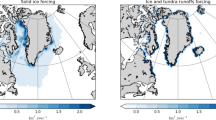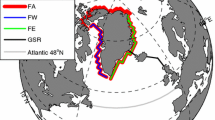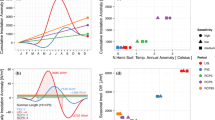Abstract
Large uncertainties exist concerning the impact of Greenland ice sheet melting on the Atlantic meridional overturning circulation (AMOC) in the future, partly due to different sensitivity of the AMOC to freshwater input in the North Atlantic among climate models. Here we analyse five projections from different coupled ocean–atmosphere models with an additional 0.1 Sv (1 Sv = 106 m3/s) of freshwater released around Greenland between 2050 and 2089. We find on average a further weakening of the AMOC at 26°N of 1.1 ± 0.6 Sv representing a 27 ± 14 % supplementary weakening in 2080–2089, as compared to the weakening relative to 2006–2015 due to the effect of the external forcing only. This weakening is lower than what has been found with the same ensemble of models in an identical experimental set-up but under recent historical climate conditions. This lower sensitivity in a warmer world is explained by two main factors. First, a tendency of decoupling is detected between the surface and the deep ocean caused by an increased thermal stratification in the North Atlantic under the effect of global warming. This induces a shoaling of ocean deep ventilation through convection hence ventilating only intermediate levels. The second important effect concerns the so-called Canary Current freshwater leakage; a process by which additionally released freshwater in the North Atlantic leaks along the Canary Current and escapes the convection zones towards the subtropical area. This leakage is increasing in a warming climate, which is a consequence of decreasing gyres asymmetry due to changes in Ekman pumping. We suggest that these modifications are related with the northward shift of the jet stream in a warmer world. For these two reasons the AMOC is less susceptible to freshwater perturbations (near the deep water formation sides) in the North Atlantic as compared to the recent historical climate conditions. Finally, we propose a bilinear model that accounts for the two former processes to give a conceptual explanation about the decreasing AMOC sensitivity due to freshwater input. Within the limit of this bilinear model, we find that 62 ± 8 % of the reduction in sensitivity is related with the changes in gyre asymmetry and freshwater leakage and 38 ± 8 % is due to the reduction in deep ocean ventilation associated with the increased stratification in the North Atlantic.















Similar content being viewed by others
References
Bamber J, van den Broeke M, Ettema J, Lenaerts J, Rignot E (2012) Recent large increases in freshwater fluxes from Greenland into the North Atlantic. Geophys Res Lett 39:L19501. doi:10.1029/2012GL052552
Belkin IM, Levitus S, Antonov J, Malmberg S-A (1998) “Great Salinity Anomalies” in the North Atlantic. Prog Oceanogr 41:1–68
Driesschaert E, Fichefet T, Goosse H, Huybrechts P, Janssens I, Mouchet A, Munhoven G, Brovkin V, Weber SL (2007) Modelling the influence of Greenland ice sheet melting on the Atlantic meridional overturning circulation during the next millennia. Geophys Res Lett 34:L1070
Durack PJ, Wijffels SE, Matear RJ (2012) Ocean salinities reveal strong global water cycle intensification during 1950 to 2000. Science 336(6080):455–458. doi:10.1126/science.1212222
Fichefet T, Poncin C, Goosse H, Huybrechts P, Janssens I, Treut HL (2003) Implications of changes in freshwater flux from the Greenland ice sheet for the climate of the 21st century. Geophys Res Lett 30:1911. doi:10.1029/2003GL017826
Ganopolski A, Rahmstorf S (2001) Rapid changes of glacial climate simulated in a coupled climate model. Nature 409(6817)
Gregory JM et al (2005) A model intercomparison of changes in the Atlantic thermohaline circulation in response to increas increasing atmospheric CO2 concentration. Geophys Res Lett 32:L12703
Hu A, Meehl GA, Han W, Yin J (2011) Effect of the potential melting of the Greenland ice sheet on the meridional overturning circulation and global climate in the future. Deep Sea Res Part II 58(17–18):1914–1926. doi:10.1016/j.dsr2.2010.10.069
Jungclaus JH, Haak H, Esch M, Roeckner E, Marotzke J (2006) Will Greenland melting halt the thermohaline circulation? Geophys Res Lett 33 (Article Number: L17708)
Kanzow T, Cunningham SA, Johns WE, Hirschi JJ-M, Marotzke J, Baringer MO, Meinen CS, Chidichimo MP, Atkinson C, Beal LM, Bryden HL, Collins J (2010) Seasonal variability of the Atlantic meridional overturning circulation at 26.5°N. J Clim 23:5678–5698. doi:10.1175/2010JCLI3389.1
Levitus S et al (1998) Introduction, vol 1. World Ocean Database 1998. NOAA Atlas NESDIS 18, NOAA/NESDIS. U.S. Dept. of Commerce, Washington, DC
Mikolajewicz U, Voss R (2000) The role of the individual air-sea flux components in CO2-induced changes of the ocean’s circulation and climate. Clim Dyn 16:627–642
Mikolajewicz U, Vizcaíno M, Jungclaus J, Schurgers G (2007) Effect of ice sheet interactions in anthropogenic climate change simulations. Geophys Res Lett 34:L18706. doi:10.1029/2007GL031173
Morita T et al (2011) 2.5.1.1 IPCC Emissions Scenarios and the SRES Process, in IPCC TAR WG3 2001
Moss RH, Edmonds JA, Hibbard KA, Manning MR, Rose SK et al (2010) The next generation of scenarios for climate change research and assessment. Nature 463:747–756
Ridley JK, Huybrechts P, Gregory JM, Lowe JA (2005) Elimination of the Greenland ice sheet in a high CO2 climate. J Clim 18:3409–3427
Rignot E, Velicogna I, van den Broeke MR, Monaghan A, Lenaerts J (2011) Acceleration of the contribution of the Greenland and Antarctic ice sheets to sea level rise. Geophys Res Lett 38:L05503
Schneider B, Latif M, Schmittner A (2007) Evaluation of different methods to assess model projections of the future evolution of the Atlantic meridional overturning circulation. J Clim 20:2121–2132
Schrama EJO, Wouters B (2011) Revisiting Greenland ice sheet mass loss observed by GRACE. J Geophys Res 116:B02407. doi:10.1029/2009JB006847.5267
Stouffer RJ, Yin J, Gregory JM, Dixon KW, Spelman MJ, Hurlin W, Weaver AJ, Eby M, Flato GM, Hasumi H, Hu A, Jungclaus JH, Kamenkovich IV, Levermann A, Montoya M, Murakami S, Nawrath S, Oka A, Peltier WR, Robitaille DY, Sokolov A, Vettoretti G, Weber SL (2006) Investigating the causes of the response of the thermohaline circulation to past and future climate changes. J Clim 19:1365–1387
Swingedouw D, Braconnot P, Marti O (2006) Sensitivity of the Atlantic meridional overturning circulation to the melting from northern glaciers in climate change experiments. Geophys Res Lett 33 (Art. No. L07711)
Swingedouw D, Braconnot P, Delecluse P, Guilyardi E, Marti O (2007) Quantifying the AMOC feedbacks during a 2×CO2 stabilization experiment with land-ice melting. Clim Dyn 29(5):521–534. doi:10.1007/s00382-007-0250-0
Swingedouw D, Mignot J, Braconnot P, Mosquet E, Kageyama M, Alkama R (2009) Impact of freshwater release in the North Atlantic under different climate conditions in an OAGCM. J Clim 22:6377–6403
Swingedouw D, Rodehacke C, Behrens E, Menary M, Olsen S, Gao Y, Mikolajewicz U, Mignot J, Biastoch A (2013) Decadal fingerprints of fresh water discharge around Greenland in a multi-models ensemble. Clim Dyn. doi:10.1007/s00382-012-1479-9
Van Meerbeeck CJ, Roche DM, Renssen H (2011) Assessing the sensitivity of the North Atlantic Ocean circulation to freshwater perturbation in various glacial climate states. Clim Dyn 37(9–10):1909–1927. doi:10.1007/s00382-011-1043-z
Vizcaíno M, Mikolajewicz U, Jungclaus J, Schurgers G (2010) Climate modification by future ice sheet changes and consequences for ice sheet mass balance. Clim Dyn 34(2–3):301–324. doi:10.1007/s00382-009-0591-y
Weaver AJ, Sedláček J, Eby M, Alexander K, Crespin E, Fichefet T, Philippon-Berthier G, Joos F, Kawamiya M, Matsumoto K, Steinacher M, Tachiiri K, Tokos K, Yoshimori M, Zickfeld K (2012) Stability of the Atlantic meridional overturning circulation: a model intercomparison. Geophys Res Lett 39:L20709. doi:10.1029/2012GL053763
Winguth A, Mikolajewicz U, Gröger M, Maier-Reimer E, Schurgers G, Vizcaíno M (2005) Centennial-scale interactions between the carbon cycle and anthropogenic climate change using a dynamic earth system model. Geophys Res Lett 32(23). doi:10.1029/2005GL023681
Wood RA, Keen AB, Mitchell JFB, Gregory JM (1999) Changing spatial structure of the thermohaline circulation in response to atmospheric CO2 forcing in a climate model. Nature 399:572–575
Yin JH (2005) A consistent poleward shift of the storm tracks in simulations of 21st century climate. Geophys Res Lett 32:L18701
Acknowledgments
The research leading to these results has received funding from the European Union’s Seventh Framework Programme (FP7/2007-2013) under grant agreement no 212643 (THOR 2008-12), no 282672 (EMBRACE 2011-2015) and no 308299 (NACLIM). CR thanks the DKRZ for providing the facilities to perform the models simulation under the BMWF project bm0579. SMO was partly supported by the Danish Council for Strategic Research. DS benefited of the HPC resources of CCRT made available by GENCI (Grand Equipement National de Calcul Intensif). We thank two anonymous reviewers for their very useful comments that improved the manuscript.
Author information
Authors and Affiliations
Corresponding author
Electronic supplementary material
Rights and permissions
About this article
Cite this article
Swingedouw, D., Rodehacke, C.B., Olsen, S.M. et al. On the reduced sensitivity of the Atlantic overturning to Greenland ice sheet melting in projections: a multi-model assessment. Clim Dyn 44, 3261–3279 (2015). https://doi.org/10.1007/s00382-014-2270-x
Received:
Accepted:
Published:
Issue Date:
DOI: https://doi.org/10.1007/s00382-014-2270-x





